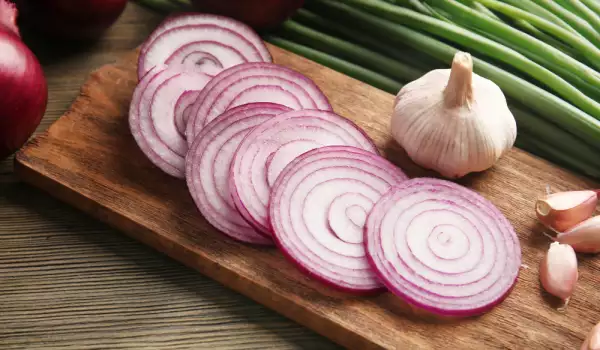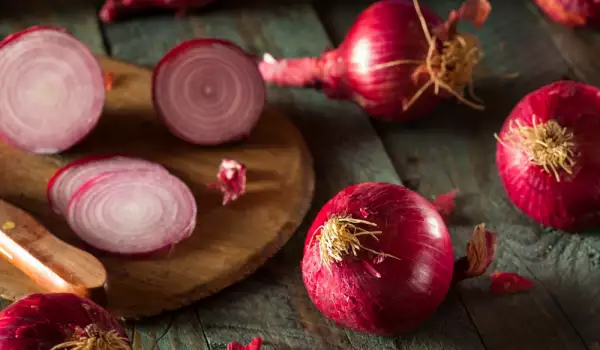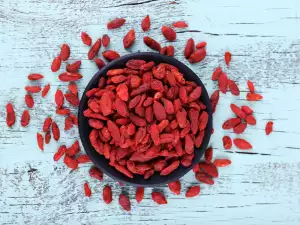In the plant kingdom, the genus Allium has kept a solid place. All its representatives - onion, garlic, shallot, leek, Chinese onion are widely known and widely used. The most cultivated of all these vegetables is the onion.
This biennial plant, grown as an annual, is cultivated and used in every part of the world and therefore Carl Linnaeus gave it much attention in his work Species Plantarum in 1753.
The synonyms of the plant are many, as are the species and onion varieties and this is understandable given the long, 7, 000-year history of selection and onion cultivation, during which time chives have disappeared.
Modern cultivars of this bulbous plant reach a height of 15 to 45 centimeters and the taste varies from sharply hot to mild and pleasantly sweet, although all species contain compounds that irritate the eyes and nasal mucosa.
One of the most popular members of the Allium genus is the red onion. What is characteristic of this variety of the spicy bulbous plant?
Classification and description of red onion
Red onion is also known as purple onion in some European countries. It is a variety of the Allium cepa plant, or as we colloquially call it - onion. It has purplish red skin and white flesh tinged with red. The main difference is observed in the color - red-violet.
The fruit is medium-sized, soft and delicate in taste. The bitterness characteristic of onions is absent in this variety and sweetness is felt instead.
Almost all varieties of red onion that exist today are of Asian origin, botanists say they come from the central parts of Asia.
There are also European varieties. The one from the island of Madeira is also decidedly sweet and is believed, that the modern Crimean onion has come from it.
Its main use is in cooking, but its skin is also used as a dye.
Red onions are often eaten raw, added to salads to add more rich color to them. It can also be grilled or cooked with other foods.
It is consumed throughout the year and to make it less pungent it can be soaked in water. It is a low-glycemic food, because it contains very few carbohydrates at the expense of fiber. Along with the other types, red also contains flavonoids, anthocyanins and other ingredients with a powerful action to preserve the health of the body. Its chemical composition deserves special attention and is good to know.

Nutritional composition of red onion
Anthocyanins are important, because they eliminate free radicals and protect the body from many diseases and red onions contain them in good doses. They can also be found in other foods such as blueberries, dark grapes, red cabbage and others. Thanks to these compounds, fruit and vegetables are colored purple and blue.
The most famous ingredient in red onion and all other varieties, is allicin. This compound has an antifungal, antibacterial and strong antioxidant effect. It supports the blood circulation process, balances blood pressure and regulates the functions of the heart.
The red vegetable is rich in chromium. This element is important for the activity of insulin in metabolic processes. Its deficiency in the body leads to insulin resistance and increases the risk of coronary heart disease.
Red onions also contain vitamin C. With its help, collagen is produced in greater quantities. Its antioxidant properties are also not to be underestimated. In order not to lose the useful ingredients, it is best to consume red onions raw or after light processing.
The amounts of quercetin, which is a flavanoid antioxidant, are very high and also of anthocyanin, which is a polyphenolic antioxidant. They prevent the fatty acids in the cells from undergoing oxidation processes. In addition, they effectively clean free radicals and thus neutralize the growth of cancer cells, while at the same time drastically reducing inflammatory processes throughout the body.
Vitamins of group B - B1, B2, B5, B6, as well as useful substances such as iodine and iron should also be added.
If we were to list all the nutrients, the list would be too long: fiber, cobalt, boron, chromium, fluorine, sulfur, phosphorus, chlorine, potassium, calcium, sodium, magnesium.
In fact, these are all the minerals and compounds that the body needs, so it is not strange that red onion helps cure many diseases.
Beneficial medicinal properties of red onion
Red onion is not the magic cure for all ailments. There is a wide range of effects, that can be used effectively.
- this type of onion has antiseptic properties, especially for sore throats, colds and respiratory syndromes;
- strengthens the heart muscle and the heart as a whole, by lowering cholesterol in the blood stream;
- removes pathogens from the eyes and nose when cutting the vegetable. The irritation of the nasal mucosa when the juices are released cleans the microbes, which drain along with the tears and prevents their reproduction;
- accelerates metabolism in the body;
- strengthens immunity, has an expectorant effect for colds and flu conditions;
- stimulates digestion;
- normalizes blood pressure;

- removes salt deposits in the body;
- supports the fight against bleeding gums and periodontal disease;
- relieves headaches;
- increases hair growth, fights acne and increases skin elasticity;
- helps the body fight many types of cancer.
Centuries ago, the beneficial properties of red onion were known, and therefore it was a mandatory product in sea expeditions, when scurvy seriously affected sailors due to lack of vitamins.
Harms from red onions
This vegetable is very healthy, but should be avoided or taken with special care in cases of severe diseases of the liver, kidneys or digestive tract.
Even with good general health, red onion is beneficial only in reasonable doses. This means 100-150 grams of onion per day. Abuse of this food in case of nervous disorders is also not recommended, as well as in case of increased excitability, because this can worsen the condition.
In order to neutralize the harmful effect of red onion, the pulp must be poured with boiled water before its use. Before that, it is good to cut the onion into thin rings. This removes the bitterness, which is characteristic of the onion.
Red onion in cooking
Red onions are used in the cooking like any other kind - in dishes, fresh or thermally processed, as well as in various canned foods. It is combined with all kinds of products and adds a pleasant sweetness to all foods in which it participates. It noticeably improves the taste of fish and meat dishes.
Storing red onions
Storage takes place in a dried form. The vegetable is made into braids and placed in a dry and ventilated room. It can even be hung as a decoration in the kitchen. It should be checked regularly for rot and mechanical damage that spoils it.
It is a great substitute for garlic in any recipe and the taste is certainly more pleasant and mild, because of the pleasant and unobtrusive sweetness.




















Comments